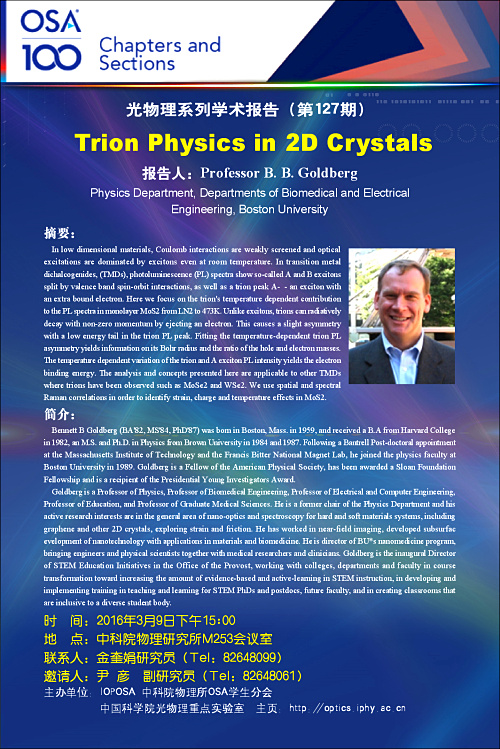题目:Trion Physics in 2D Crystals
报告人:Professor B. B. Goldberg, Physics Department, Departments of Biomedical and Electrical Engineering, Boston University
摘要:
In low dimensional materials, Coulomb interactions are weakly screened and optical excitations are dominated by excitons even at room temperature. In transition metal dichalcogenides, (TMDs), photoluminescence (PL) spectra show so-called A and B excitons split by valence band spin-orbit interactions, as well as a trion peak A- - an exciton with an extra bound electron. Here we focus on the trion's temperature dependent contribution to the PL spectra in monolayer MoS2 from LN2 to 473K. Unlike excitons, trions can radiatively decay with non-zero momentum by ejecting an electron. This causes a slight asymmetry with a low energy tail in the trion PL peak. Fitting the temperature-dependent trion PL asymmetry yields information on its Bohr radius and the ratio of the hole and electron masses. The temperature dependent variation of the trion and A exciton PL intensity yields the electron binding energy. The analysis and concepts presented here are applicable to other TMDs where trions have been observed such as MoSe2 and WSe2. We use spatial and spectral Raman correlations in order to identify strain, charge and temperature effects in MoS2.
简介:
Bennett B Goldberg (BA'82, MS'84, PhD'87) was born in Boston, Mass. in 1959, and received a B.A from Harvard College in 1982, an M.S. and Ph.D. in Physics from Brown University in 1984 and 1987. Following a Bantrell Post-doctoral appointment at the Massachusetts Institute of Technology and the Francis Bitter National Magnet Lab, he joined the physics faculty at Boston University in 1989. Goldberg is a Fellow of the American Physical Society, has been awarded a Sloan Foundation Fellowship and is a recipient of the Presidential Young Investigators Award.
Goldberg is a Professor of Physics, Professor of Biomedical Engineering, Professor of Electrical and Computer Engineering, Professor of Education, and Professor of Graduate Medical Sciences. He is a former chair of the Physics Department and his active research interests are in the general area of nano-optics and spectroscopy for hard and soft materials systems, including graphene and other 2D crystals, exploring strain and friction. He has worked in near-field imaging, developed subsurface solid immersion microscopy for Si inspection, and imaging through strongly scattering media like tissue and rock. His group is working on novel approaches to subcellular imaging, biosensors and single virus imaging.
Goldberg is former Director of Boston University's Center for Nanoscience and Nanobiotechnology, an interdisciplinary center that brings together academic and industrial scientists and engineers in the development of nanotechnology with applications in materials and biomedicine. He is director of BU’s nanomedicine program, bringing engineers and physical scientists together with medical researchers and clinicians. Goldberg is the inaugural Director of STEM Education Initiatives in the Office of the Provost, working with colleges, departments and faculty in course transformation toward increasing the amount of evidence-based and active-learning in STEM instruction, in developing and implementing training in teaching and learning for STEM PhDs and postdocs, future faculty, and in creating classrooms that are inclusive to a diverse student body.
时间:2016年3月9日下午15:00
地点:中科院物理研究所M253会议室
联系人:金奎娟 研究员 (Tel:82648099)
邀请人:尹 彦 副研究员(Tel:82648061)
主办单位:IOPOSA 中科院物理所OSA学生分会
中国科学院光物理重点实验室









